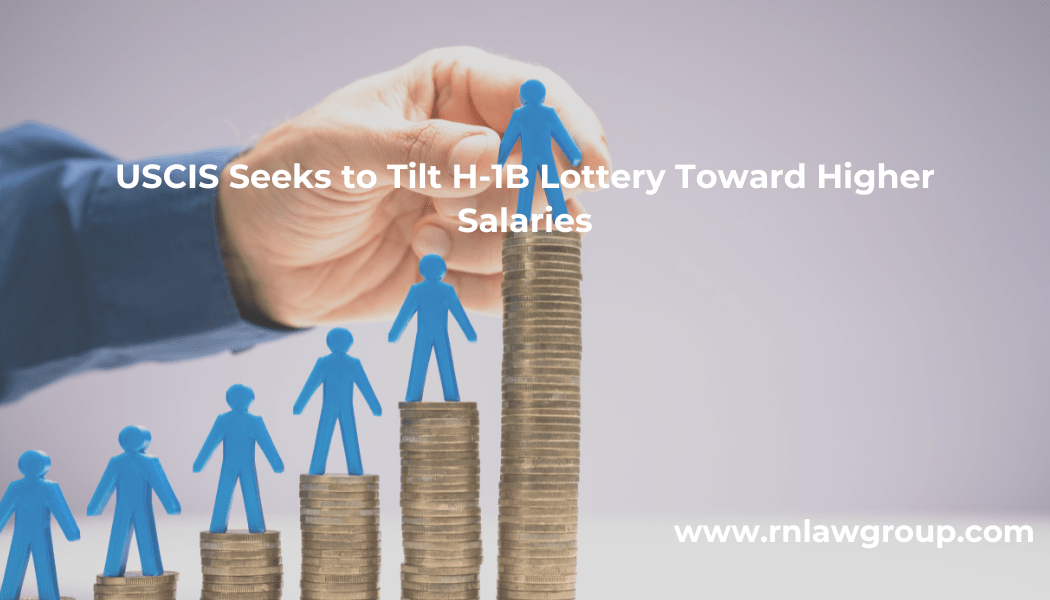
USCIS Seeks to Tilt H-1B Lottery Toward Higher Salaries
Since its creation under the Immigration Act of 1990, the H-1B visa program has been capped at a set number of annual slots that are consistently oversubscribed. This has forced U.S. Citizenship and Immigration Services (USCIS) to rely on lottery systems to allocate visas. For years, selection was based on a simple random lottery, with a modest advantage for advanced degree holders. In 2019, the Department of Homeland Security (DHS) implemented the electronic registration system, and in 2024, USCIS shifted to a beneficiary-centric model to prevent duplicate filings.
Previous administrations floated more dramatic reforms—most notably the 2020–2021 rule that would have ranked registrations strictly by wage level, effectively eliminating most entry-level positions. That rule was vacated in federal court and withdrawn before implementation. The newly proposed regulation takes a different approach: instead of a rigid wage-ranking system, it introduces a weighted lottery. Higher Occupational Employment and Wage Statistics (OEWS) wage levels will receive multiple entries in the selection pool, boosting their odds of selection without completely shutting out lower-level jobs.
The Core Change: Weighted Odds by Wage Level
When a lottery is required, each unique H-1B beneficiary will be entered into the selection pool multiple times depending on the OEWS wage level that the proffered wage meets or exceeds for the relevant Standard Occupational Classification (SOC) code and area of intended employment:
- Level IV: 4 entries
- Level III: 3 entries
- Level II: 2 entries
- Level I: 1 entry
Each beneficiary is still selected only once, but higher wage levels carry better odds. The same process applies to the advanced degree exemption after the regular cap is met.
What the Registration Form Will Collect
Employers must now provide and certify:
- The SOC code for the proffered position;
- The area of intended employment (if multiple worksites or multiple positions, the lowest equivalent wage level applies);
- The highest OEWS wage level that the proffered wage meets or exceeds for that SOC and location;
- Passport or travel document information for the beneficiary (each beneficiary can only be registered under one valid passport/travel document).
Key guardrails:
- If using a private wage survey and the proffered wage is below OEWS Level I, employers must still select Level I.
- If a wage range is used, the level is based on the lowest number in the range.
- All details must align with the petition and Labor Condition Application (LCA).
Beneficiary-Centric with “Lowest of Registrations” Assignment
If multiple employers register the same worker at different wage levels, USCIS will assign that beneficiary to the lowest wage level submitted before weighting their odds. For example, if one employer submits at Level IV and another at Level I, the beneficiary will be treated as Level I (one entry). This closes the loophole of inflating wages to boost selection odds.
Petition Stage: Match Registration Exactly
Unless registration is suspended, an H-1B petition is only valid if it is based on a selected registration and contains identical information—including SOC code, wage level, and location—as the registration and LCA. Petitioners must also submit supporting evidence of the wage level determination as of the registration date.
Limited changes may be permitted, such as legal name changes, passport renewals, or location shifts consistent with the original bona fide job offer and wage level.
Integrity Rules: Certifications, Denials, and Related Entities
- Truthfulness requirement: Employers must certify all information is accurate. Any fraud, misrepresentation, or invalid job offer may result in denial or revocation.
- Anti-gaming provision: USCIS may deny a new or amended petition if it appears designed to manipulate lottery odds—for example, lowering the wage to a lower level after selection.
- Related entity rule: “Related entity” extends beyond ownership or control to include familial ties, shared leadership, overlapping worksites, or substantially similar supporting documentation. USCIS will apply a “totality of the circumstances” test.
DOL Prevailing Wage Rules Unchanged—for Now
This regulation does not alter how the Department of Labor (DOL) sets prevailing wage levels. It only uses the OEWS level to weight USCIS’s selection odds. However, President Trump’s recent Proclamation on Restriction on Entry of Certain Nonimmigrant Workers directs DOL to initiate a separate rulemaking that could raise prevailing wage levels in line with administration policy goals.
Ultimate Impact: Shift Away from Entry-Level Jobs
The proposed system aims to significantly reduce the number of visas going to entry-level positions. Each year, the proposal estimates that H-1B visas for Level I jobs would drop by about 10,000, while higher-paid roles would see gains:
- +2,400 visas for Level II
- +4,500 visas for Level III
- +3,200 visas for Level IV
Conclusion
While USCIS frames the proposed weighted lottery as aligning with congressional intent to attract highly skilled workers, the statute points in a different direction. INA § 214(g)(3), 8 U.S.C. § 1184(g)(3) requires that H-1B visas “shall be issued … in the order in which petitions are filed.” Historically, this has been read to permit random selection when filings arrive simultaneously, but not to authorize weighting some petitions more heavily than others. Critics are likely to argue that the proposed regulation conflicts with this statutory command, raising questions of ultra vires action and vulnerability under the Administrative Procedure Act. Litigation could mirror the 2021 wage-ranking rule, which was vacated in court before taking effect.
Next Steps in the Rulemaking Process
The proposal is scheduled for publication in the Federal Register on September 24, 2025. Once published, the public will have:
- 30 days to submit comments on the rule itself, and
- 60 days to comment on related information collection requirements (e.g., new data fields on the registration form).
USCIS must then review comments, draft a final rule, secure review from the Office of Management and Budget (OMB), and publish the final regulation. Even with an accelerated schedule, this process generally takes several months.
Can It Be Finalized by March 2026?
The H-1B registration window typically opens in March for the upcoming fiscal year. To apply the weighted lottery for FY 2027 (lottery in March 2026), the rule would need to be finalized and effective well before registration begins. Agencies often provide at least 30 days’ notice after publication of a final rule, especially when IT systems must be updated. That leaves a narrow timeline: DHS would need to publish the final rule by late 2025 or very early 2026 for it to realistically apply to the next lottery.
Given the likelihood of legal challenges—potentially seeking preliminary injunctions—the effective date could be delayed even if a final rule is issued quickly. Employers should therefore prepare for both possibilities: that the weighted lottery is in place for March 2026, or that litigation or timing delays force USCIS to run one more year under the current beneficiary-centric random system.
By: Emily Neumann
Emily Neumann is Managing Partner at Reddy Neumann Brown PC with over 15 years of experience practicing US immigration law providing services to U.S. businesses and multinational corporations. Emily has helped transform the firm from a solo practice to Houston’s largest immigration law firm focused exclusively on U.S. employment-based immigration. She received her Bachelor’s degree in Biology from Central Michigan University and her Juris Doctorate degree from the University of Houston Law Center. Emily has been quoted in Bloomberg Law, U.S. News & World Report, Inside Higher Ed, and The Times of India on various hot topics in immigration. She is a member of the American Immigration Lawyers Association and Society for Human Resource Management.

